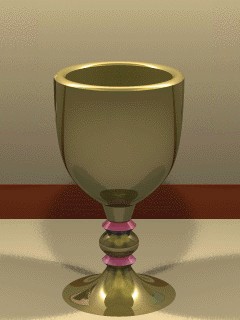Gold - 79Au: physical properties
Gold is a soft metal with a number of interesting physical properties. Gold is both malleable and ductile. Gold is a heavy metal (density 19.3 g cm-3) and one gram of gold can be hammered out into a thin sheet of gold a metre in area, and just 230 atoms or so thick. Gold leaf is translucent and the transmitted light is greenish blue (gold metal reflects yellow and red, leaving the greenish blue colour. One gram of gold can be drawn into a thin wire 165 metres long and just 20 micrometres thick. X-ray data suggest electrons from filled d bands near the electron energy surface of the s-p conduction band are excited by near ultraviolet and blue energies, giving rise to the characteristic gold colour of the metal.
Density properties
 Density of solid: 19300 kg m‑3
Density of solid: 19300 kg m‑3 Molar volume: 10.21 cm3
Molar volume: 10.21 cm3
Elastic properties
 Young's modulus: 78 GPa
Young's modulus: 78 GPa Rigidity modulus: 27 GPa
Rigidity modulus: 27 GPa Bulk modulus: 220 GPa
Bulk modulus: 220 GPa Poisson's ratio: 0.44 (no units)
Poisson's ratio: 0.44 (no units)
Hardnesses
 Mineral hardness: 2.5 (no units)
Mineral hardness: 2.5 (no units) Brinell hardness: 2450 MN m-2
Brinell hardness: 2450 MN m-2 Vickers hardness: 216 MN m-2
Vickers hardness: 216 MN m-2


Electrical properties
 Electrical resistivity: 2.2 × 10‑8 Ω m; or mΩ cm
Electrical resistivity: 2.2 × 10‑8 Ω m; or mΩ cm
Heat and conduction
 Thermal conductivity: 320 W m‑1 K‑1
Thermal conductivity: 320 W m‑1 K‑1 Coefficient of linear thermal expansion: 14.2 × 10‑6 K‑1
Coefficient of linear thermal expansion: 14.2 × 10‑6 K‑1
Optical properties

The image above is a virtual representation of gold metal calculated by Patrick Callet using the complex diectric function of the element only.
 Reflectivity: 95 %
Reflectivity: 95 % Refractive index: (no data) (no units)
Refractive index: (no data) (no units)
Acoustic properties
 Velocity of sound: 1740 m s‑1
Velocity of sound: 1740 m s‑1
